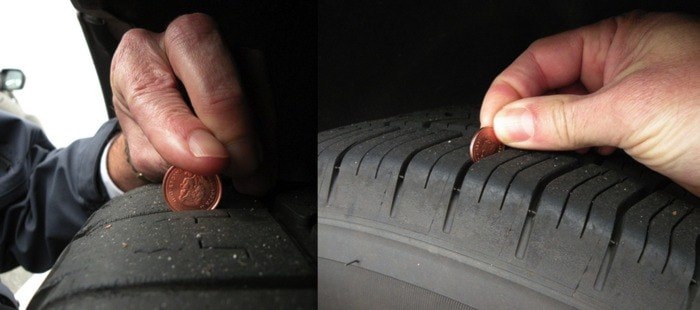With icy roads coming soon, the RCMP have a two-fold message for drivers – use the right tires on your vehicle and make sure you have enough tread on your tires to stay safe.
In the Lower Mainland, the right tires will depend on where you’re driving and what your expectations are for your tires.
“All season mud and snow tires, while currently legal, are not good winter tires,” advises Supt. Norm Gaumont, head of traffic services for the RCMP in the Lower Mainland.
“Tires need to have the mountain snowflake emblem on them, to be true winter tires. And either winter tires or chains are required by law, if you’re traveling in many areas in Whistler or in the Interior.”
Once temperatures fall below seven degrees Celsius, winter tires will provide better traction than all-season tires, which translates to shorter stopping distances and better vehicle cornering and control.
Gaumont notes that there are all-season tires with a snowflake emblem, but they’re not yet that common, and can cost more.
Drivers should also use the penny test to determine if their tires have enough tread depth, generally at least 3.5 mm. Hold a penny upside down and insert it into the tread of front and rear tires. If the Queen’s head is fully visible, the tire doesn’t have enough tread.
“Drivers shouldn’t rely solely on the advanced safety features of modern cars – such as ABS braking or airbags,” notes Gaumont. “It takes two minutes to check the tread on your tires, and that could make the difference for you and your family. Having good tire tread allows you to stop in time, prevents crashes, and helps keep you from hydroplaning. If you constantly feel your ABS system activating, you are driving too fast for the conditions. In effect, you are removing the advantage that ABS provides.”
In fact, research conducted by the government of Quebec in the two years since winter tire use became universal in that province has proven that winter tires save lives and reduce injuries.
The 2011 study, which compared Quebec road accident statistics before and after winter tire use became required, shows that in the past two winters there has been a five-per-cent reduction in road accident injuries that can be directly attributed to winter tire use. The research concludes that winter tires prevent about 575 road accident injuries per winter in Quebec. The study also found that vehicle accidents resulting in death or serious injury declined by three per cent.
“When people ride on winter tires, road-accident injuries decrease,” says Glenn Maidment, president of the Rubber Association of Canada (RAC), which represents tire makers. “Considering that only 51 per cent of Canadian motorists use winter tires, the Quebec experience should give us all pause for thought. There now can be absolutely no doubt that winter tires offer the safest winter driving experience.”
This fall tire makers are urging Canadian drivers to carefully consider whether winter tires are right for them and to make an educated choice. To help motorists make the right decision for their driving patterns, the industry is offering drivers a wealth of information about the performance advantages of winter tires at its website, betiresmart.ca.
What motorists may not know is that today’s high-tech winter tires offer far more than better traction on snow, ice or slush covered roadways. The rubber compounds used in today’s sophisticated winter tires deliver better grip in all cold weather driving conditions – including dry pavement – because these compounds maintain their elasticity even at temperatures below minus-30 degrees Celsius. The result is a dramatic improvement in driver control and traction in all winter driving conditions, particularly when cornering or braking.
Drivers who choose to put on winter tires will notice the difference in traction when the temperature falls below seven degrees Celsius, or as soon as they can see their breath.
Traditionally, many drivers, particularly those who live in cities or towns where the streets are cleared regularly, have opted for all-season tires to avoid the bi-annual tire changeover. All-season tires can provide safe all-weather performance, but winter tires deliver up to 50 per cent more winter traction.
“The most common objection to winter tires is cost,” says Maidment. “But that concern is tempered by the fact that using winter tires prolongs the life of a vehicle’s conventional summer tires, which over time saves money. Given the performance and safety advantages, winter tires should be considered a driving essential from December to April.”
When buying winter tires, motorists should look for the mountain snowflake symbol on the sidewall. Tires with this symbol meet or exceed tire industry snow traction requirements.
Proper tire maintenance and inflation are also important contributors to safe winter driving.
Motorists should remember that excessive tread wear can diminish traction and, as a result, tread depth should always be checked at the start of the winter driving season. Drivers who are unsure if their tires are overly worn should consult their tire retailer to determine if they should be replaced.
Proper tire inflation is another winter driving essential. Tires that are under- or over-inflated have a smaller footprint on the road surface, which lessens their grip. The result is reduced stopping and handling capabilities and wasted fuel.
Tire inflation pressure can drop quickly during cold snaps. Every five degrees Celsius change results in about one psi change in pressure, so a temperature drop of 15 degrees Celsius would result in 10 per cent or three psi under-inflation. During winter, tire makers recommend measuring tire inflation frequently using a reliable tire gauge to ensure tires are properly inflated to the vehicle manufacturer’s recommendation.
